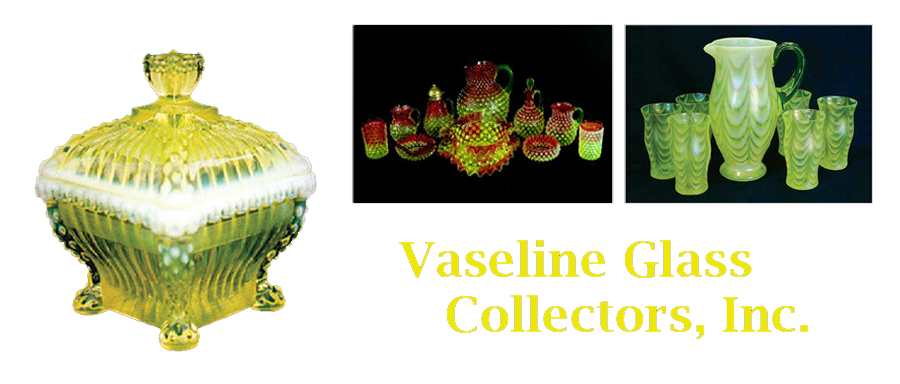What Is Vaseline Glass?
There are different definitions of what is or is not “vaseline glass” and it depends a lot on in what part of the world you are located. But simply put, “vaseline glass” is uranium glass which is ‘yellow’ as opposed to other glass of various shades of green, custard, jade, etc. This is referring to the basic color of vaseline glass and does not take into account various forms of decoration.
The VGCI adopted this definition years ago:
“Vaseline Glass is a particular color of yellow-green glass that is made by adding as little as 0.1% to 0. 2% Uranium Dioxide to the ingredients when the glass formula is made. The addition of the Uranium Dioxide makes the glass color yellow-green. Vaseline glass is ALWAYS verifiable by using an ultraviolet light (blacklight) on the glass item. When this is done, the glass turns a bright florescent green! Sometimes, even the most trained eye can be fooled by a piece of glass that looks like vaseline glass, but without the addition of uranium, the glass will not ‘glow’ or fluoresce bright green under a blacklight.”
Not all yellow-green glass will turn florescent green when a UV light is shined on it. That is why it is important to carry a UV light to verify because “if it doesn’t glow green, it’s not vaseline!”
Other kinds of glass which contain uranium dioxide do glow green but by definition are not vaseline glass. For example, depression glass will glow green. Burmese glass – both old and new will glow green and custard glass, ranging from the pale off-white to bright green will glow green too. Each one of these types ‘glow’ due to the addition of Uranium Dioxide to the glass formula.
Definitions Can Be Confusing
Members of the VGCI consider vaseline glass to be yellow or yellow-green. A glass dish can look yellow under incandescent lighting, but when it is taken outdoors, the UV of the sun will tickle the atoms, making the same piece look yellow-green. Also, when a flash camera is used on vaseline glass, it will make it appear more green than the eyes do, because the intense flash also ‘tickles’ the uranium atoms.
Vaseline glass (in the USA) is defined by the VGCI to first, be yellow to yellow-green and second, to glow green under a UV light. Other countries have their own definition for vaseline glass. For instance, people in Australia use the words, ‘vaseline glass’ for any type of glass that has an opalescent rim. What we consider to be vaseline glass, they call citron or uranium glass. The British in the United Kingdom refer to any glass that has a whispy opalescent treatment to be vaseline glass. What they call ‘Primrose Pearline’ (a trade name from Geo. Davidson & Son) is what the US collectors call ‘vaseline glass’. In Germany, they did not differentiate and call all of it ‘uranglas’ and it can be yellow or green, as long as it has uranium in it and glows under a blacklight. True vaseline glass does not have iron oxide added to the formula, which makes green depression glass a separate formula, and thus, is not considered to be vaseline glass.
Vaseline Glass was primarily made from 1840, up to just before WWII, and then was continued from 1959 to the present. Vaseline Glass was in its heyday during the Victorian period from the 1880’s to the 1920’s. The yellow-green glass did not sell as well as other colors of glass, so during the depression years, glass manufacturers started adding iron oxide to the glass mixture (but still included the Uranium Dioxide) and this had the effect of making the glass green. Because of this, most green depression glass will glow. The government confiscated all supplies of uranium during WWII and halted all production of vaseline glass from approximately 1943 until the ban was lifted in Nov. 1958.
Only after years of testing by the various regulatory departments of the government were glass companies once again allowed to make this glass. In Victorian times, glassblowers who made Vaseline Glass usually died at a relatively young age of lung cancer, and the ‘stories’ have persisted for years that this was due to their exposure to molten Vaseline Glass. However, when this information was discussed with different experts on radiation (from University of Missouri and University of Oklahoma), they felt that there may have been other reasons for their early demise, as radiation tends to affect the thyroid glands the most. This topic will likely be a subject for long debate.
Vaseline Glass is not harmful, as the emissions from the glass are just slightly stronger than normal background radiation that we are all exposed to on a daily basis.
Due to the tight regulations on Uranium Dioxide and the expense of this ingredient, only very limited quantities are being produced today. Because of this, most collectors are aware of the limited nature of its production and this is reflected in the marketplace.
